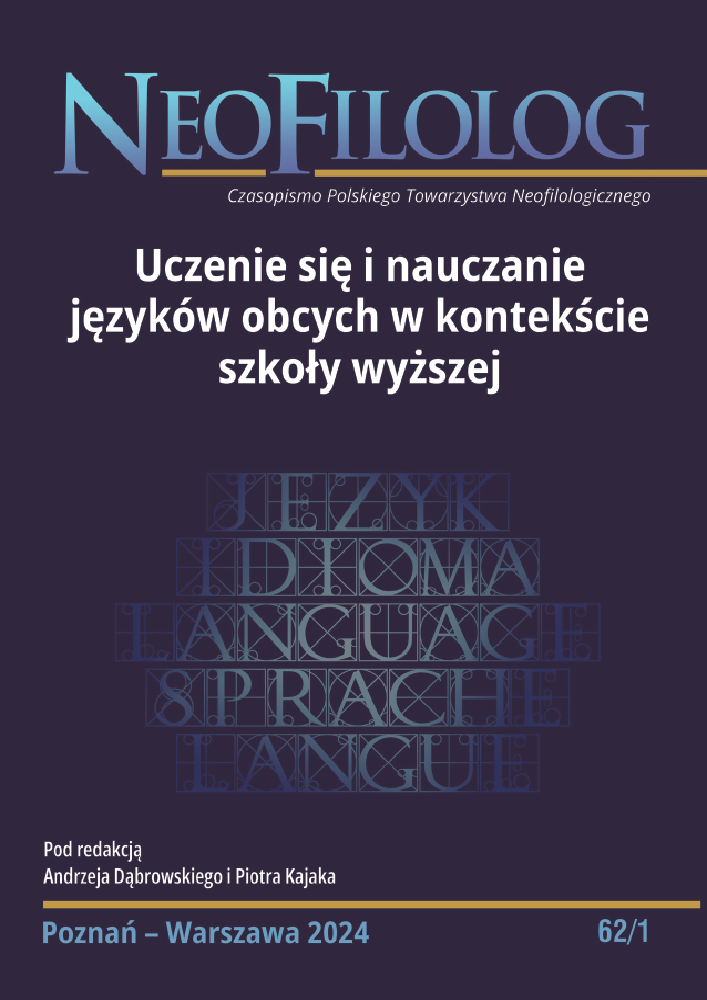Abstrakt
In the didactics of languages and cultures, mediation often enters into a relationship with translation. After the publication of the Common European Framework of Reference for Languages in 2001, mediation was mainly associated with linguistic transcoding and equated with translation. In the CEFR – Companion volume (2020), the understanding of mediation has been considerably broadened, taking into account the multilingual and multicultural perspective of language use and the conditions for interaction between people with different lifestyles and views. The aim of the paper is to reflect in depth on the nature of the concepts of ‘mediation’ and ‘translation’. Both are interdisciplinary in nature and their main vehicle is language. But there are also many differences between them which do not allow the terms to be used interchangeably. In an analysis of a comparative nature, we will try to show the most important determinants of the mediation and translation process, referring to their use in the context of language learning and teaching.
Bibliografia
Bada V. (2016), Traduction et médiation: pour une pensée aporétique de la traduction postcoloniale, (w:) Servais Ch. (red.), La médiation. Théorie et terrains, Louvain-la-Neuve: De Bœck Supérieur, s. 165–182. DOI: https://doi.org/10.3917/dbu.serva.2016.01.0165
Biedermann A. (2014), La médiation linguistique dans un contexte d’enseignement des langues étrangères. „Synergies Chili”, nr 10, s. 83–91. Online: https://gerflint.fr/Base/Chili10/biedermann.pdf [DW 20.09.2023].
Bohle F. (2014), Sprachmittlung im Fremdsprachenunterricht: Mit Anwendungsbeispielen für den Spanischunterricht. Hamburg: Diplomica Verlag.
Coste D., Cavalli M. (2015), Education, mobility, otherness. The mediation functions of schools. Strasbourg: Council of Europe.
Council of Europe. (2020), Common European Framework of Reference for Languages: Learning, teaching, assessment – Companion volume. Strasbourg: Council of Europe Publishing.
Dendrinos B. (2006), Mediation in communication, language teaching and testing. „Journal of Applied Linguistics”, nr 22, s. 9–35.
Dwużnik P. (2022), Mediacja a tłumaczenie w glottodydaktyce. „Języki Obce w Szkole”, nr 1, s. 115–125.
Gajda A. (2014), Mechanizmy spójnościowe w dawnych tekstach popularnonaukowych, (w:) Kornacka M. (red.), Spójność tekstu specjalistycznego, Warszawa: Wydawnictwo Naukowe Instytutu Kulturologii i Lingwistyki Antropocentrycznej UW, s. 7–20.
Guillaume-Hofnung M. (2013) [1995], La médiation. Paris: Presses Universitaires de France. DOI: https://doi.org/10.3917/puf.guill.2012.01
Janowska I. (2016), Od metody gramatyczno-tłumaczeniowej do mediacji językowej. Tłumaczenie w dydaktyce języków obcych, (w:) Lipińska E., Seretny A. (red.), Tłumaczenie dydaktyczne w nowoczesnym kształceniu językowym, Kraków: Księgarnia Akademicka, s. 37–53.
Janowska I., Plak M. (2021), Działania mediacyjne w uczeniu się i nauczaniu języków obcych. Od teorii do praktyki. Kraków: Księgarnia Akademicka. DOI: https://doi.org/10.12797/9788381386807
Janowska I. (2023), Tâches de médiation comme outils d’enseignement/apprentissage actionnel des langues étrangères. „Neofilolog”, nr 60/2, s. 363–379. DOI: https://doi.org/10.14746/n.2023.60.2.6
Kolb E. (2009), Finite Resources – Infinite Communication: Sprachmittlung im Englischunterricht der Unterstufe. „ForumSprache”, nr 1, s. 69–86. Online: https://www.hueber.de/media/36/ForumSprache_01_2009_Artikel05-Kolb_978-3-19-006100-6-2.pdf [DW 20.09.2023].
La médiation, nouvelle liberté publique, 2007, wywiad z Michèle Guillaume-Hofnung. Online: https://www.irenees.net/bdf_fiche-entretien-66_fr.html [DW 20.09.2023].
Leoncini Bartoli A. (2020), La médiation à la lumière de la traduction ou ‘dénouer des sacs de nœuds’, (w:) de Gioia M., Marcon M. (red.), L’essentiel de la médiation. Le regard des sciences humaines et sociales, Bruxelles: Peter Lang, s. 211–231.
North B., Piccardo E. (2016), Developing illustrative descriptors of aspects of mediation for the Common European Framework of Reference (CEFR). Strasbourg: Council of Europe. DOI: https://doi.org/10.1017/S0261444816000100
Piotrowski S., Sadowska-Dobrowolska K. (2020), Tłumaczenie pisemne na język polski: o spójności tekstu docelowego. „Roczniki Humanistyczne”, t. LXVIII, z. 10, s. 89–102. DOI: https://doi.org/10.18290/rh206810-7
Podpora-Polit E. (2020), Tłumaczenie jako narzędzie rozwijania umiejętności językowych. „Języki Obce w Szkole”, nr 1, s. 65–71.
Rada Europy. (2003), Europejski system opisu kształcenia językowego: uczenie się, nauczanie, ocenianie, Warszawa: Wydawnictwa CODN.
Reimann D. (2014), Sprachmittlung, ProDaZ: Deutsch als Zweitsprache in allen Fächern. Online: https://www.uni-due.de/imperia/md/content/prodaz/reimann_sprachmittlung.pdf [DW 20.09.2023]
Six J.-F. (1990), Le temps des médiateurs. Paris: Seuil.
Wach A. (2017), Techniki bilingwalne w nauczaniu gramatyki języka obcego. „Języki Obce w Szkole”, nr 1, s. 22–27.
Licencja
Prawa autorskie (c) 2024 Iwona Janowska

Utwór dostępny jest na licencji Creative Commons Uznanie autorstwa – Bez utworów zależnych 4.0 Międzynarodowe.
Przedstawiany utwór (artykuł) upubliczniany jest na podstawie umowy z autorem i na licencji Creative Commons Attribution-NoDerivatives 4.0 International (CC BY-ND 4.0).
Użytkownicy mają obowiązek podania wraz z rozpowszechnionym utworem, informacji o autorstwie, tytule, źródle (odnośniki do oryginalnego utworu, DOI) oraz samej licencji;
- bez tworzenia utworów zależnych,
- utwór musi być zachowany w oryginalnej postaci.
Uniwersytet im. Adama Mickiewicza w Poznaniu zachowuje prawo do czasopisma jako całości (układ, forma graficzna, tytuł, projekt okładki, logo itp.).

